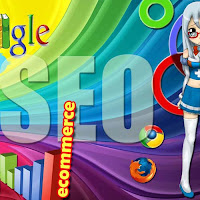By Hector Cisneros
 |
| Courtesy of Pixabay |
Selling products and services
online is a multi-billion-dollar industry. In fact, it’s a 427-billion-dollar industry in
the US alone. Worldwide 1.61 billion people purchased
goods and services online. However, many seasoned
businesses are struggling to find significant returns on their eCommerce investments.
An article in BIG Commerce states that many retailers are struggling to capitalize on their
digital sales channels. Today eCommerce competition is fierce. Whether
you’re competing directly with the giant eCommerce retailers like Amazon, eBay, and Walmart, or you're struggling to get your
unique new product found in the sea of online sales sites, today you must be strategic
and have all your eCommerce ducks in a row. If your web pages don’t have all their
T’s crossed and I’s dotted, people will simply
go to your competitor and buy from them instead. In this episode of Working the
Web to Win, we will cover all the important
aspects needed to produce your secret sauce to create a successful eCommerce website
business. So, keep reading and learn how to make your eCommerce dream a reality.
 |
| Courtesy of Pixabay |
Now that you know about these costs, make sure you go through the exercise
of creating a spreadsheet cost model to make sure you have the funds to make your
eCommerce dream a reality. If you already have an eCommerce site and haven’t done this exercise, it’s time to
do it so you fully understand your operation.
Can you Fail to Succeed? - Nothing in business teaches a more
valuable lesson than failure! Today an eCommerce site has to be very focused and
strategic. A great article in BIG commerce by Jason Boyce
talks about a company that turned a $1 million loss that taught them how to be strategic,
which in turn showed them how to turn that
lesson into a $22,000,000 gain. So, being strategic is critical for survival during
recessions and for the long haul. Now let’s talk about some common mistakes businesses
make when setting up their eCommerce sites.
Common Mistakes Made
One of the Most Common Mistakes we see is when a small business
builds an eCommerce site
using the Field of Dreams theory of marketing, i.e., If you build it they will come - wrong! Marketing
your site is critical to the success of any
online business. This is true whether you
have a minimal budget and must use word of mouth and guerilla tactics or you have
a site on Amazon or eBay where tens of thousands
of vendors compete head-to-head for customers. If you’re just getting started and
your spreadsheet model shows that you have enough profit margin to use an aggregation
company like Amazon or eBay, I suggest you
do so. These platforms have all the infrastructure you need to get started and minimize
any security risks that you incur. However, understand these giant aggregators have
extensive compliance rules that you also must follow.
 |
| Courtesy of Wikimedia Commons |
The Second Most Common Mistake we see is trying to drive traffic
to the home page. In our article called What Your Webmaster Should be Telling You,
we lay out the new rules that help landing pages convert visitors into customers.
The reality is, “website Home pages” don’t rank very well for specific keywords,
usually because they have too many keywords on them. Companies often fail to create
landing pages for their ON-Sale items. Landing pages, which are sometimes called
splash pages, microsites or focused sales pages, are necessary to narrow the search
keywords and keep the prospect focused on their intended goal. When a prospect types
in a search term looking for an item, they usually end up narrowing their choices
to find the best fit for their needs. An example would be to type in fruit when
they are looking for bananas. Eventually, savvy web surfers learn to simply type bananas. A landing page that is focused on a single search term will rank much
better than a web page with multiple search
terms if all other SEO factors are equal.
 |
| Courtesy of Pixabay |
Traffic is also a major SEO factor. Traffic is important for two reasons.
First, if no one sees your product no one will buy it. Second, search engines look
at traffic as a vote for the value of your web page.
This is one of the main reasons businesses
engage in pay per click advertising; it produces
traffic when implemented properly. Your efforts should be focused on driving traffic to your landing pages from your blog and
social sites, (often if not daily). Your post needs
to talk about these products in a soft sell, informational approach, with educational
videos, testimonials and by providing eBooks and white papers that talk about case
studies of your product. It is critical that SEO factors are relevant, timely, perceived
as useful, and are delivered as infotainment (informational and entertaining).
The Fourth Most Common Mistake
- we see is that the landing
pages, when used, are mainly informational. Any web page you send traffic to needs
to be compelling. Many businesses we see use Wordpress pages that have large banners
taking up most of the space above the fold. This leaves little room for compelling
elements that are needed to make the customer feel confident your business is trustworthy.
Today all sites must be secure showing an HTTPS designation. They also need to provide
elements that build trust. For example; real contact information like a physical
address and phone number need to be added to the homepage. Testimonial videos are
another must, (read How to Turn Your Best Customers into Your Best
Salespeople).
 |
| Courtesy of Flickr |
How are businesses getting people to
buy from them online? Here is a checklist of several marketing venues you should
look at and experiment with to see which will provide the best return on investment.
- Organic SEO Marketing - If you’re in a very competitive market, then this is one of the most important things to be successful. That being said, SEO no longer just means Search Engine Optimization of your web pages. It now incorporates search engine optimization of everything you publish online. This means every web page, social post, every blog, video, podcast and press release must be optimized, balancing usefulness to the end user and driving traffic to your eCommerce properties.
- Blogging for Business - Blogs are the
new de facto magazines for the world today. The great
thing about using a blog for marketing is that it has multi-media capabilities. This allows you to provide a media rich, compelling product with useful information for the prospect, while providing you with trust and credibility. A blog is also a full-fledged website that can support eCommerce. It also always gives a prospect a reason to come back - that of a new interesting and useful article for them to read. Blog articles are perfect fodder for the social networks. A blog can be a great audience builder, and this audience can be independent of the search engines. Once you develop a following, you can also monetize your blog by adding banner ads from one of the banner networks like AdSense.
Courtesy of Pixabay - Video Marketing - YouTube, Facebook, and Twitter offer video platforms where you can provide video content marketing messages. These can be used to increase your credibility, show off customer testimonials, provide videos to support product usage, provide a video that tells your story, including your “about us,” ”unique selling proposition” and your “feature/benefit product” video. Like Blogging, it can be used to build an audience that is independent of the search engines. It is also an ideal content piece for posting to the social nets.
- Podcasting - Like blogs and
video marketing, podcasting can be used as
a content marketing
medium. It will require a time investment on your part to build an audience. We do a weekly show on BlogTalk Radio that turns into a podcast at the end of each show. We push the show out before each episode and then also put like to the show on our websites and social nets.
Courtesy of WorkingTheWebToWin.com - Social Media Marketing - Today consumer sentiment determines the credibility of companies and products. Testimonials and high ratings turn prospects into buyers. Engaging in social media marketing means much more than just providing ads on a social platform, it means providing a useful, authoritative and curated post to build a loyal and trusting audience. This audience can also be independent of the search engines. A positive testimonial post from a happy customer can become your next Advertisement that drives new sales.
- Using Aggregation Sales Platforms - like Amazon, eBay,
Jet, and Walmart come with
millions of shoppers who trust and are committed to using these platforms. For the exchange of following their rules and paying them their commission, they give you access to their customers. However, understand that they already support millions of vendors and that your product will not be found unless you optimize the product content properly. You will also have to use their promotional platforms or pay per click to push your product to the top of their list.
Courtesy of Wikimedia Commons - Pay Per Click - AdWords, Video PPC on YouTube, Social PPC (Facebook, Twitter, LinkedIn, Instagram, etc.…) and other pay per click platforms offer a quick way to get to the top of the search engines. When executed properly the return on investment can be a good one. However, understand that most PPC platforms are complicated and have many marketing parameters that must be setup correctly. Otherwise, you can throw away a lot of money very quickly. That is why we offer a free pay per click audit for potential clients. We have been able to save clients as much as fifty percent off what they were getting without using our methods. On top of the fees you normally pay for the media buy (to Adwords or other vendors), there are usually management fees (around 35% on top of the media buy). Here we can save the client money again because our management fee is one of the lowest in the industry (we charge 20% or less).
- Banner Advertising - Banner advertising
can be used in conjunction with PPC or as a
standalone effort. It is usually used with re-targeting platforms and can be a very effective way of getting traffic to your landing pages. It is usually cheaper than PPC, but it does not always translate into a high ROI. You are not just stuck with using the big banner companies like Google, Yahoo, Bing and AOL, you can also create a banner on your websites, blogs, and social sites, where you control the cost and message size. You can even use your banner to generate revenue from partner companies that you sell to directly to or by using Google or other banner networks as plug ins on your sites.Courtesy of WorkingTheWebToWin.com - Email blast and Newsletters - If you're using free eBook offers and collecting prospect and customer contact information, you can engage in email blast and newsletters. Your list must consist of opt-in subscribers and your message must be useful, focus and compelling to produce results. You can buy list, but they also must be opt-in subscribers, otherwise, you can be fined for spamming to the tune of 11,000 per incident! Also, if you abuse your subscriber list, by sending them too many marketing messages they will simply un-subscribe.
- Texting Platforms - Like email marketing,
you can gather mobile phone numbers via an opt-in
list on your websites, blogs, and social sites. Often this type of marketing is tied to mobile apps that require the subscriber's contact information as part of getting the app for free. You can then push out your information or marketing messages to your subscribers as needed. If you have a loyal subscriber base, these types of messages can produce instant results, but it does take experimentation, and you must take care of your subscriber base. Otherwise, they will just us-subscribe!
Courtesy of Pixabay - Digital Press Releases - Press releases have been used to generate hype and interest since the invention of the printing press. Digital press releases are no different, except for the fact that they can be sent to hundreds of media outlets and can reach millions of people very quickly. They can also rank quickly in the search engines, but unfortunately, their ranking factor also fades just as quickly. They work extremely well for timed events like concerts, community events and other annual or seasonal events. They can also provide interest for important business, invention, project or discovery announcements. They can target local media companies, regional territories, specific industry concerns, just the US or even the whole world.
Making your eCommerce website profitable
is achievable if you’re willing to put in the time for research, strategic planning
and experimenting with the different marketing venues available to your company.
It should go without saying that you must strive to provide the best content and
quality you're capable of producing. You also
must be selling a product or service that provides real value to consumers. If you
cross your t’s and dot your I’s as listed in this
article you will be successful. If you find you need help, we can offer several
different cost-effective marketing methods to help you reach your sales goals.
This article provides the reader a list
of important factors that lead to eCommerce success. This article includes important
financial factors, many common marketing mistakes businesses make and a comprehensive
list of the pros and cons of viable marketing venues. Also included are various
other articles and resources.
 |
| Get your FREE copy today! |
If you found this article useful, please share it with friends, family, and co-workers. I recommend checking out the links in the blog, along with checking out other related articles on our Show Notes Page. Don’t forget to listen to the BlogTalkRadio show on this subject. If you have a related useful comment or opinion about this article, leave it in the comment section of this blog. Also, don’t forget to plus us, on Google+ and share us on Facebook, Twitter, and LinkedIn as well.
Hector Cisneros is COO and Director
of Social Media Marketing at Working
the Web to Win, an award-winning Internet marketing company based in
Jacksonville, Florida. He is also co-host of the weekly Internet
radio show, "Working
the Web to Win" on BlogTalkRadio.com, which airs every Tuesday at 4
p.m. Eastern. Hector is a syndicated writer and published author of “60 Seconds to Success.”












I am impressed. I don't think I've met anyone who knows as much about this subject as you do. You are truly well informed and very intelligent. You wrote something that people could understand and made the subject intriguing for everyone. Really, great blog you have got here.
ReplyDeleteB2B Marketplace